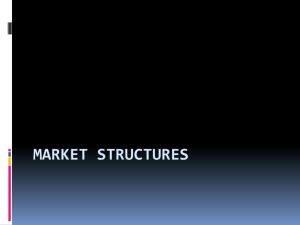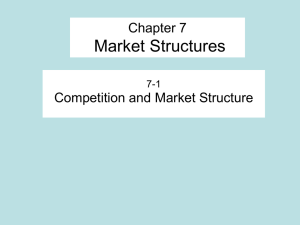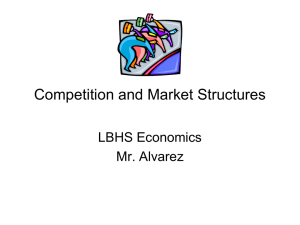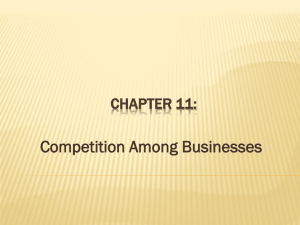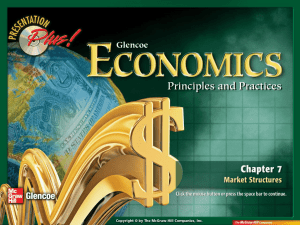Market Structures Chapter 7
advertisement
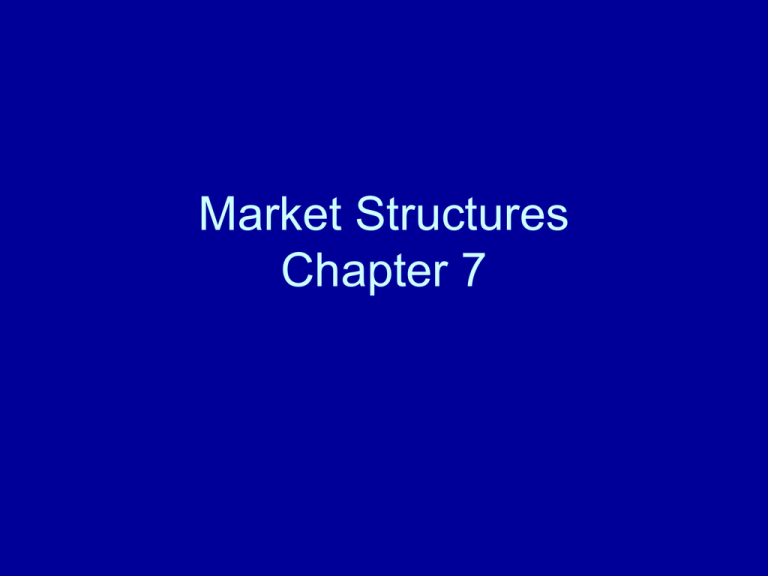
Market Structures Chapter 7 Competition and Market Structures Section 1 Perfect Competition • Perfect competition is a market structure with large numbers of buyers and sellers, identical economic products, independent action by buyers and sellers, reasonably well-informed participants, and freedom for firms to enter or leave the market. • Perfect competition is a largely-theoretical situation used as a benchmark to evaluate other market structures. Market situations lacking one or more of these conditions are called imperfect competition. Discussion Question Imagine that your town had an open farmers’ market during the spring and summer. How would it meet each condition for a perfectly competitive market? Monopolistic Competition • Monopolistic competition has all the characteristics of perfect competition except for identical products. • Monopolistic competitors use product differentiation-the real or imagined differences between competing products in the same industry. • Monopolistic competitors use nonprice competition, the use of advertising, giveaways, or other promotional campaigns to differentiate their products from similar products in the market. • Monopolistic competitors sell within a narrow price range but try to raise the price within that range to achieve profit maximization. • What are some examples of how different jean companies differentiate their products? Oligopoly • Oligopoly is a market structure in which a few very large sellers dominate the industry. • Oligopoly is further away from perfect competition (freest trade) than monopolistic competition. • Oligopolists act interdependently by lowering prices soon after the first seller announces the cut, but typically they prefer nonprice competition because their rivals cannot respond as quickly. • Oligopolists may all agree formally to set prices, called collusion, which is illegal (because it restricts trade). • Two forms of collusion include: 1. price-fixing, which is agreeing to charge a set price that is often above market price; 2. dividing up the market for guaranteed sales. • Oligopolists can engage in price wars, or a series of price cuts that can push prices lower than the cost of production for a short period of time. • Oligopolists’ final prices are likely to be higher than under monopolistic competition and much higher than under perfect competition. • Why do you suppose oligopolists rarely protest when a rival raises its prices? Monopoly • Monopoly is a market structure with only one seller of a particular product. • The Unites States has few monopolies because Americans prefer competitive trade, and technology competes with existing monopolies. • Natural monopoly occurs when a single firm produces a product or provides a service because it minimizes the overall costs (public utilities). • Geographic monopoly occurs when the location cannot support two or more such businesses (small town drugstore). • Technological monopoly occurs when a producer has the exclusive right through patents or copyrights to produce or sell a particular product (an artist's work for his lifetime plus 50 years). • Government monopoly occurs when the government provides products or services that private industry cannot adequately provide (uranium processing). • The monopolist is larger than a perfect competitor, allowing it to be the price maker versus the price taker. ? • Why are monopolies unappealing to Americans? Market Failures ` Section 2 Inadequate Competition • Decreases in competition because of mergers and acquisitions can lead to several consequences that create market failures. • Inefficient resource allocation often results when there's no incentive to use resources carefully. • Reduced output is one way that a monopoly can retain high prices by limiting supply. • A large business can exert its economic power over politics. • Market failures on the demand side are harder to correct than failures on the supply side. • Imagine you are on a city council and a leading auto manufacturer that employs thousands demands a reduced tax rate or it will relocate. What alternatives might there be to granting or refusing the tax break? Inadequate Information • Consumers, businesspeople, and government officials must be able to obtain market conditions easily and quickly. • If they cannot, it is an example of market failure. • What resources would you check to find out how the weather has affected the citrus industry this year? Resource Immobility • Resource immobility occurs when land, capital, labor, and entrepreneurs stay within a market where returns are slow and sometimes remain unemployed. • When resources will not or cannot move to a better market, the existing market does not always function efficiently. Externalities • Externalities are unintended side effects that either benefit or harm a third party. • Negative externalities are harm, cost, or inconveniences suffered by a third party. • Positive externalities are benefits received by someone who had nothing to do with the activity that created the benefit. • Externalities are market failures because the market prices that buyers and sellers pay do not reflect the costs and/or the benefits of the action. Public Goods • Public goods are products everyone consumes. • The market does not supply such goods because it produces only items that can be withheld if people refuse to pay for them; the need for public goods is a market failure. The Role of Government Section 3 Antitrust Legislation • The antitrust laws prevent or break up monopolies, preventing market failures due to inadequate competition. • The Sherman Antitrust Act (1890) was the first U.S. law against monopolies. • The Clayton Antitrust Act (1914) outlawed price discrimination. • The Federal Trade Commission (1914) was empowered to issue cease and desist orders, requiting companies to stop unfair business practices. • The Robinson-Patman Act (1936) outlawed special discounts to some customers. Government Regulation • Government’s goal in regulating is to set the same level of price and service that would exist if a monopolistic business existed under competition. • The government uses the tax system to regulate businesses with negative externalities, preventing market failures. Public Disclosure • Public disclosure requires businesses to reveal information about their products or services to the public. • The purpose of public disclosure is to provide adequate information to prevent market failures. • Corporations, banks, and other lending institutions must disclose certain information. There are also “truth-in-advertising” laws that prevent sellers fro making false claims about their products. Indirect Disclosure • Indirect disclosure includes government’s support of the Internet and the availability of government documents on government Web sites. • Businesses post information about their own activities on their own Web sites. Modified Free Enterprise • Government intervenes in the economy to encourage competition, prevent monopolies, regulate industry, and fulfill the need for public goods. • Today’s U.S. economy is a mixture of different market structures, different kinds of business organizations and varying degrees of government regulation.
